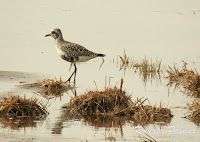BLACK-BELLIED PLOVER
BLACK-BELLIED PLOVER – (Pluvialis squatarola) – (See images below)
DESCRIPTION: The Black-bellied Plover, also called Grey Plover, is easy to identify for a male in breeding plumage. As the name indicates the upper part of the belly is black, as well as the throat and breast. The lower belly is white, and there is also a white edge bordering the upper black parts. The back and wings are spotted white and black. In non-breeding plumage however, the black plumage of the male is replaced by white with grey streaks. The bill and neck are black, as well as the legs, which are relatively long. Females are similar to the non-breeding male. At approximately 30 cm (12 in.) long, the black-bellied plover is the largest plover in North America.
VOICE: https://www.xeno-canto.org/species/Pluvialis-squatarola
NAME: The name ‘plover’ comes from Latin ‘pluvia’ – rain. It was thought that these birds were somehow associated with rain. The Latin species name ‘squatarola’ comes from Italian ‘sgatarola’ for ‘grey plover’ (the name of this species outside North America).
HABITAT: Arctic tundra around the world in its native range. During migration and on their wintering grounds, the birds are found in coastal areas such as beaches and also around the Great Lakes.
DIET: Plovers are shorebirds that feed on crustaceans and insects.
NESTING: The nest is a simple scrape on the tundra gravel. About four eggs are laid. They are brown orange with dark blotches.
DISTRIBUTION: This plover nests in the Arctic on the tundra. The black-bellied plover is a long distance migratory bird and winters in coastal areas around the world, including on Hawaii.
DISTRIBUTION MAP: https://en.wikipedia.org/wiki/Grey_plover#/media/File:Pluvialis_squatarola_map.svg
ON PEI: The black-bellied plover is very common in Prince Edward Island during its migration only (spring through fall), as it does not breed on this island.
CONSERVATION: This bird is easily alarmed, which helped to save him from hunters. However, being more sensitive to disturbance the black-bellied plover will flee its nest more frequently than other species, but this behavior does not seem to impact its numbers so far. Its population trends are difficult to assess however due to the remoteness of the species breeding areas, but it is not considered at risk.
SIMILAR SPECIES: American Golden Plover, Pacific Golden Plover, European Golden Plover
REFERENCES: https://en.wikipedia.org/wiki/Grey_plover
https://www.allaboutbirds.org/guide/Black-bellied_Plover/id
https://www.audubon.org/field-guide/bird/black-bellied-plover
https://www.birdwatchersdigest.com/bwdsite/learn/identification/shorebirds/black-bellied-plover.php
http://birdweb.org/birdweb/bird/black-bellied_plover
DESCRIPTION: The Black-bellied Plover, also called Grey Plover, is easy to identify for a male in breeding plumage. As the name indicates the upper part of the belly is black, as well as the throat and breast. The lower belly is white, and there is also a white edge bordering the upper black parts. The back and wings are spotted white and black. In non-breeding plumage however, the black plumage of the male is replaced by white with grey streaks. The bill and neck are black, as well as the legs, which are relatively long. Females are similar to the non-breeding male. At approximately 30 cm (12 in.) long, the black-bellied plover is the largest plover in North America.
VOICE: https://www.xeno-canto.org/species/Pluvialis-squatarola
NAME: The name ‘plover’ comes from Latin ‘pluvia’ – rain. It was thought that these birds were somehow associated with rain. The Latin species name ‘squatarola’ comes from Italian ‘sgatarola’ for ‘grey plover’ (the name of this species outside North America).
HABITAT: Arctic tundra around the world in its native range. During migration and on their wintering grounds, the birds are found in coastal areas such as beaches and also around the Great Lakes.
DIET: Plovers are shorebirds that feed on crustaceans and insects.
NESTING: The nest is a simple scrape on the tundra gravel. About four eggs are laid. They are brown orange with dark blotches.
DISTRIBUTION: This plover nests in the Arctic on the tundra. The black-bellied plover is a long distance migratory bird and winters in coastal areas around the world, including on Hawaii.
DISTRIBUTION MAP: https://en.wikipedia.org/wiki/Grey_plover#/media/File:Pluvialis_squatarola_map.svg
ON PEI: The black-bellied plover is very common in Prince Edward Island during its migration only (spring through fall), as it does not breed on this island.
CONSERVATION: This bird is easily alarmed, which helped to save him from hunters. However, being more sensitive to disturbance the black-bellied plover will flee its nest more frequently than other species, but this behavior does not seem to impact its numbers so far. Its population trends are difficult to assess however due to the remoteness of the species breeding areas, but it is not considered at risk.
SIMILAR SPECIES: American Golden Plover, Pacific Golden Plover, European Golden Plover
REFERENCES: https://en.wikipedia.org/wiki/Grey_plover
https://www.allaboutbirds.org/guide/Black-bellied_Plover/id
https://www.audubon.org/field-guide/bird/black-bellied-plover
https://www.birdwatchersdigest.com/bwdsite/learn/identification/shorebirds/black-bellied-plover.php
http://birdweb.org/birdweb/bird/black-bellied_plover
 |
| Black-bellied plover - St. George Island State Park, FL - Roberta Palmer |
 |
| Black-bellied plover, breeding female PEI, 2013 - by Roberta Palmer |